What is…
Sinai and Mount Sinai in the Bible
also known as: Horeb
Hebrew: סִינַי —transliteration: Sinay —meaning: of Sin (of the Moon god) —occurrences: 35
Sinai Wilderness
Sinai is the name of the mountain wilderness region which was reached by the Hebrews in the 3rd month after the Exodus (Exodus 19:1).
Here they remained encamped for about a whole year. Their journey from the Red Sea to this encampment, including all the windings of the route, was about 150 miles. The last 22 chapters of Exodus, together with the whole of Leviticus and Numbers 1-11, contain a record of all the important things that occurred while they were here.
From Rephidim (Exodus 17:8-13) the Israelites journeyed forward into “the desert of Sinai,” and encamped there “before the mountain.”
Mount Sinai
also known as: Mount Horeb, Mountain of Elohim, Mountain of YHWH
Hebrew: סִינָֽי׃ הַ֥ר —transliteration: har Sinai —meaning: Mount Sinai
This is a place of great importance in Scripture, and the events that happened here are referred to many times in the Bible. God told Moses to “set apart this place as holy,” and “the glory of Yahweh dwelt on Mount Sinai” (Exodus 24:16).
and let them be ready for the third day, for on the third day Yahweh will come down on Mount Sinai in the sight of all the people. —Exodus 19:11 LSB
Now Mount Sinai was all in smoke because Yahweh descended upon it in fire; and its smoke ascended like the smoke of a furnace, and the whole mountain trembled violently. —Exodus 19:18 LSB
And Yahweh came down on Mount Sinai, to the top of the mountain; and Yahweh called Moses to the top of the mountain, and Moses went up. —Exodus 19:20 LSB
When He had finished speaking with him upon Mount Sinai, He gave Moses the two tablets of the testimony, tablets of stone, written by the finger of God. —Exodus 31:18 LSB
Now it happened when Moses was coming down from Mount Sinai (and the two tablets of the testimony were in Moses’ hand as he was coming down from the mountain), that Moses did not know that the skin of his face shone because of his speaking with Him. —Exodus 34:29 LSB
Then You came down on Mount Sinai,
And spoke with them from heaven;
You gave them upright judgments and true laws,
Good statutes and commandments. —Nehemiah 9:13 LSB
This was the scene of the giving of the law. From the Mount Sinai the law was proclaimed to the people encamped below in the plain.
During the lengthened period of their encampment here the Israelites passed through a very memorable experience. An immense change passed over them. They are now an organized nation, bound by covenant engagement to serve the Lord their God, their ever-present divine Leader and Protector.
At length, in the second month of the second year of the Exodus, they move their camp and march forward according to a prescribed order. After three days they reach the “wilderness of Paran,” the “et-Tih”, i.e., “the desert”, and here they make their first encampment.
At this time, a spirit of discontent broke out amongst them, and the Lord manifested his displeasure by a fire which fell on the encampment and inflicted injury on them. Moses called the place Taberah, Numbers 11:1-3.
- What are the 10 Commandments?
- The Decalogue
- Why followers of Christ should use The Ten Commandments in evangelism? Answer
- Have you kept each of the Ten Commandments? Are you good enough to go to Heaven? Answerlip>
The exact location of the Bible’s Mount Sinai is not absolutely certain. The traditional site is Jabal Mousa (Musa).
Jabal Mousa
also known as: Jabal Musa, Mount Moses
Arabic: جَبَل مُوسَىٰ, —meaning: “Mountain of Moses”

The journey between this Mount Sinai candidate and the southern boundary of The Promised Land at Kadesh (about 150 miles) was accomplished in about a year.
This is the mountain traditionally considered to be the one where where God met with Moses and delivered the Ten Commandments. It is located on the Sinai Peninsula of modern Egypt. It is 7,497 feet high (2,285 meters).
Alternative suggested locations for Mount Sinai
 Jabal al-Halāl (aka Jabal Helal), northern Sinai Peninsula, Egypt [Claude Scudamore Jarvis, “The forty years' wandering of the Israelites”, Palestine Exploration Quarterly, 70:25–40 (1938) / Claude Scudamore Jarvis, Yesterday and Today in Sinai (London: W. Blackwood and Sons, 1938), pp. 165–184. / C.H.J. de Geus, “Kadesh Barnea: Some geographical and historical remarks”, in Brongers, Hendrik Antonie, editor, Instruction and Interpretation: Studies in Hebrew Language, Palestinian archaeology and biblical exegesis (Leiden: Brill Archive, 1977] / Google Map
Jabal al-Halāl (aka Jabal Helal), northern Sinai Peninsula, Egypt [Claude Scudamore Jarvis, “The forty years' wandering of the Israelites”, Palestine Exploration Quarterly, 70:25–40 (1938) / Claude Scudamore Jarvis, Yesterday and Today in Sinai (London: W. Blackwood and Sons, 1938), pp. 165–184. / C.H.J. de Geus, “Kadesh Barnea: Some geographical and historical remarks”, in Brongers, Hendrik Antonie, editor, Instruction and Interpretation: Studies in Hebrew Language, Palestinian archaeology and biblical exegesis (Leiden: Brill Archive, 1977] / Google Map Jabal Sinn Bishr (aka Gabal Sin Bishar), western central Sinai Peninsula, Egypt [NIV Atlas of the Bible, Zondervan, and Menashe Har-El, The Sinai Journeys: The Route of the Exodus, Revised Edition (Ridgefield Publishing Company: 1981)] / Google Map
Jabal Sinn Bishr (aka Gabal Sin Bishar), western central Sinai Peninsula, Egypt [NIV Atlas of the Bible, Zondervan, and Menashe Har-El, The Sinai Journeys: The Route of the Exodus, Revised Edition (Ridgefield Publishing Company: 1981)] / Google Map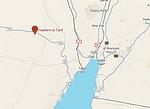 Hashem El Tarif, eastern central Sinai Peninsula, Egypt (James Cameron, “The Exodus Decoded”, History Channel, and Simcha Jacobovici, “The Naked Archaeologist,” TV series) / Simcha Jacobovici, “The Real Mount Sinai,” in Session 3 of “(Re)Locating Mount Sinai: A Survey of Alternative Theories” (Mount Sinai–Mount Karkom?: Mizpe Ramon, 2013). / Google Map
Hashem El Tarif, eastern central Sinai Peninsula, Egypt (James Cameron, “The Exodus Decoded”, History Channel, and Simcha Jacobovici, “The Naked Archaeologist,” TV series) / Simcha Jacobovici, “The Real Mount Sinai,” in Session 3 of “(Re)Locating Mount Sinai: A Survey of Alternative Theories” (Mount Sinai–Mount Karkom?: Mizpe Ramon, 2013). / Google Map Mount Serbal (aka Jebel Serbal and Gebel Nakús), southern Sinai Peninsula, Egypt [ D. Ludwig Schneller, “Durch die Wüste zum Sinai”, Kommissionsverlag von H. G. Wallmann (1910), p. 189. / Samuel Colcord Bartlett, From Egypt to Palestine Through Sinai, the Wilderness and the South Country (New York, NY: Harper, 1879), pp. 238–84. / W.M. Flinders Petrie, Researches in Sinai (New York: Dutton, 1906), pp. 206, 247–254. / John Lewis Burckhardt, Travels in Syria and the Holy Land (London: John Murray, 1822). / Eduard Rüppell, Reisen in Nubien, Kordofan, Und Dem Petraischen Arabien (Frankfurt am Main: Friedrich Wilmans, 1829).] / Google Map
Mount Serbal (aka Jebel Serbal and Gebel Nakús), southern Sinai Peninsula, Egypt [ D. Ludwig Schneller, “Durch die Wüste zum Sinai”, Kommissionsverlag von H. G. Wallmann (1910), p. 189. / Samuel Colcord Bartlett, From Egypt to Palestine Through Sinai, the Wilderness and the South Country (New York, NY: Harper, 1879), pp. 238–84. / W.M. Flinders Petrie, Researches in Sinai (New York: Dutton, 1906), pp. 206, 247–254. / John Lewis Burckhardt, Travels in Syria and the Holy Land (London: John Murray, 1822). / Eduard Rüppell, Reisen in Nubien, Kordofan, Und Dem Petraischen Arabien (Frankfurt am Main: Friedrich Wilmans, 1829).] / Google Map Mount Catherine (aka Gabal Katrîne), southern Sinai Peninsula, Egypt / Google Map
Mount Catherine (aka Gabal Katrîne), southern Sinai Peninsula, Egypt / Google Map Jebel el Madhbab (aka Jebel al-Madhbah, Jabal al-Madhbaḥ), at Petra, Jordan [Ditlef Nielsen, The Site of the Biblical Mount Sinai: A Claim for Petra (Paris: Paul Geuthner, 1928) / Arthur Samuel Peake, editor, Peake’s Commentary on the Bible (1919)] / Google Map
Jebel el Madhbab (aka Jebel al-Madhbah, Jabal al-Madhbaḥ), at Petra, Jordan [Ditlef Nielsen, The Site of the Biblical Mount Sinai: A Claim for Petra (Paris: Paul Geuthner, 1928) / Arthur Samuel Peake, editor, Peake’s Commentary on the Bible (1919)] / Google Map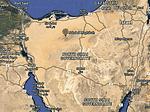 Jabal al Maghārah (aka Jabal Magharah, جبل المغارة), northwestern Sinai Peninsula, Egypt / Google Map
Jabal al Maghārah (aka Jabal Magharah, جبل المغارة), northwestern Sinai Peninsula, Egypt / Google Map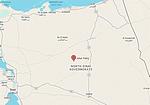 Jabal Yalliq (aka Jabal Yelleq, Jebel Yeleq, Gebel Yelleg, Jebel Ya’allaq, Gebel Yi`allaq, Jabal Yu`alliq, Ras Abu Qurun, جبل يعلق), northwestern Sinai Peninsula, Egypt / Google Map
Jabal Yalliq (aka Jabal Yelleq, Jebel Yeleq, Gebel Yelleg, Jebel Ya’allaq, Gebel Yi`allaq, Jabal Yu`alliq, Ras Abu Qurun, جبل يعلق), northwestern Sinai Peninsula, Egypt / Google Map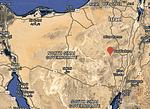 Har Karkom (aka Mount Karkom, Jabal Karkoum, Jabal Ideid, הר כרכום), southwest Negev desert in Israel [Emmanuel Anati, The riddle of Mount Sinai: archaeological discoveries at Har Karkom (2001) and James K. Hoffmeier, Ancient Israel in Sinai: The Evidence for the Authenticity of the Wilderness Tradition (Oxford University Press: 2005), p. 126.] / Google Map
Har Karkom (aka Mount Karkom, Jabal Karkoum, Jabal Ideid, הר כרכום), southwest Negev desert in Israel [Emmanuel Anati, The riddle of Mount Sinai: archaeological discoveries at Har Karkom (2001) and James K. Hoffmeier, Ancient Israel in Sinai: The Evidence for the Authenticity of the Wilderness Tradition (Oxford University Press: 2005), p. 126.] / Google Map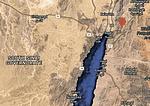 Jabal Baqir (aka Jabal Baqr, Jabal Ahmad al Baqir), Aqaba, Jordan [Charles Tilstone Beke, Sinai in Arabia and of Median (1878)] / Google Map
Jabal Baqir (aka Jabal Baqr, Jabal Ahmad al Baqir), Aqaba, Jordan [Charles Tilstone Beke, Sinai in Arabia and of Median (1878)] / Google Map Willow Peak (aka Ras es-Safsafeh, Ras Sasafeh, Sufsafeh, Ras Sufsafeh, رأس صفصافة), sourthern Sinai Peninsula, Egypt / Google Map
Willow Peak (aka Ras es-Safsafeh, Ras Sasafeh, Sufsafeh, Ras Sufsafeh, رأس صفصافة), sourthern Sinai Peninsula, Egypt / Google Map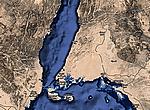 Jabal al-Lawz (aka Jabel e-Lawz, Jabel Maqla, Jabal Maqlā, جَبَل ٱللَّوْز), northwest Saudi Arabia, Tabuk Province, near the Jordanian border, above the Gulf of Aqaba (promoted by Bob Cornuke, Ron Wyatt, Lennart Möller / Larry R. Williams, The Mountain of Moses: The Discovery of Mount Sinai (New York, NY: Wynwood, 1990).) / Bob Robert Cornuke and David Halbrook, In Search of the Mountain of God: The Discovery of the Real Mt. Sinai (B&H Publishing Group: 2000) / Mary Nell Wyatt, “Mt. Sinai,” The Discoveries of Ron Wyatt (1994) / Lennart Möller, The Exodus Case: New Discoveries Confirm the Historical Exodus, 3rd extended edition (Copenhagen, Denmark: Casscom Media, Scandinavia Publishing, 2008). / Google Map
Jabal al-Lawz (aka Jabel e-Lawz, Jabel Maqla, Jabal Maqlā, جَبَل ٱللَّوْز), northwest Saudi Arabia, Tabuk Province, near the Jordanian border, above the Gulf of Aqaba (promoted by Bob Cornuke, Ron Wyatt, Lennart Möller / Larry R. Williams, The Mountain of Moses: The Discovery of Mount Sinai (New York, NY: Wynwood, 1990).) / Bob Robert Cornuke and David Halbrook, In Search of the Mountain of God: The Discovery of the Real Mt. Sinai (B&H Publishing Group: 2000) / Mary Nell Wyatt, “Mt. Sinai,” The Discoveries of Ron Wyatt (1994) / Lennart Möller, The Exodus Case: New Discoveries Confirm the Historical Exodus, 3rd extended edition (Copenhagen, Denmark: Casscom Media, Scandinavia Publishing, 2008). / Google Map Hala-'l Badr (aka Hala-'l Bedr, Hallat al Badr, Hallat el-Badr, حلا البدر), volcano cinder cone, in the land of Midian [Charles Beke, Mount Sinai, a Volcano (1873)] / Colin J. Humphreys, The Miracles of the Exodus: A Scientist’s Discovery of the Extraordinary Natural Causes of the Biblical Stories (London and New York, NY: Continuum, 2003)./ Google Map
Hala-'l Badr (aka Hala-'l Bedr, Hallat al Badr, Hallat el-Badr, حلا البدر), volcano cinder cone, in the land of Midian [Charles Beke, Mount Sinai, a Volcano (1873)] / Colin J. Humphreys, The Miracles of the Exodus: A Scientist’s Discovery of the Extraordinary Natural Causes of the Biblical Stories (London and New York, NY: Continuum, 2003)./ Google Map- Jabal Al-Manifa (aka Jabal Manifa), Saudi Arabia (Alois Musil, a Czech theologian, orientalist, explorer / Harry St. John Bridger Philby, The Land of Midian (London: Ernest Benn, 1957).)
More Information
- Who is Moses?
- The story of Moses (illustrated)
- Want to see God? Here’s a true story about Moses, a man who really, really wanted to see God. —Go
- Story of the giving of The Ten commandments
- What are the 10 Commandments?
- The Decalogue
- the fear of the Lord— What is it? Why is it very important? Answer
- Have you kept each of the Ten Commandments? Are you good enough to go to Heaven? Answer
- About the miracles of the Bible, with comprehensive list
- Is it logical to believe that the biblical miracles really happened? Answer
- “Miracles are not possible,” some claim. Is this true? Answer
- What is Horeb?
- The wilderness of Sin
- Sin—the wilderness
- The land of Sinim
- Sinite
- Sinaiticus codex
- The Exodus
- What is the Book of Exodus?
- encamp
- camp
- What is the Law of Moses?
- Who is Jethro?
- Book of Leviticus
- Sin-offering
- clouds
- murmuring
- wandering
- Names and Titles of God
- Moon—worship
- About idolatry and false gods in the Bible
 Learn about archaeology and the Bible
Learn about archaeology and the Bible
